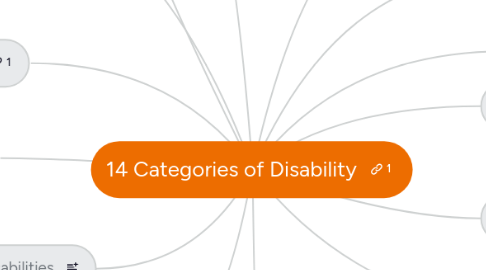
1. Multiple disabilities
2. Orthopedic impairment
2.1. Neuromotor impairments
2.1.1. Fine and gross motor skills instruction and support
2.1.2. Augmentative communication and assistive devices
2.1.3. Occupational Therapy, Physical Therapy, Speech-Language pathologist
2.2. Degenerative diseases
2.2.1. Fine and gross motor skills instruction and support
2.2.2. Augmentative communication and assistive devices
2.2.3. Occupational Therapy, Physical Therapy, Speech-Language pathologist
2.3. Musculoscelative disorders
2.3.1. Fine and gross motor skills instruction and support
2.3.2. Augmentative communication and assistive devices
2.3.3. Occupational Therapy, Physical Therapy, Speech-Language pathologist
3. Specific learning disability
3.1. Break tasks into smaller steps
3.2. Extended times for tests and assignments
3.3. Use of audiobooks to replace reading materials
3.4. Use of computer software to spell and grammar check
3.5. Give directions verbally as well as in writing
4. Speech and language impairment
4.1. Speech impairment
4.1.1. Fluency
4.1.1.1. Assistive technology - electronic communication system
4.1.1.2. Allow students extra time to express themselves
4.1.1.3. Speech and language pathology services
4.1.1.4. mnemonic devices
4.1.1.5. Do not call on in class
4.1.2. Articulation
4.1.2.1. Assistive technology - electronic communication system
4.1.2.2. Allow students extra time to express themselves
4.1.2.3. Speech and language pathology services
4.1.2.4. mnemonic devices
4.1.2.5. Do not call on in class
4.1.3. Voice
4.1.3.1. Assistive technology - electronic communication system
4.1.3.2. Allow students extra time to express themselves
4.1.3.3. Speech and language pathology services
4.1.3.4. mnemonic devices
4.1.3.5. Do not call on in class
4.2. Language impairment
4.2.1. Assistive technology - electronic communication system
4.2.2. Allow students extra time to express themselves
4.2.3. Speech and language pathology services
4.2.4. mnemonic devices
5. Traumatic brain injury
5.1. Extended time of work and tests
5.2. Model tasks and activities
5.3. Use daily assignment-book or schedule
5.4. Allow more breaks to rest
5.5. Break down directions into multiple, small steps
6. Intellectual disability
6.1. Teach life and social skills
6.2. Break down instructions into smaller steps
6.3. Transition planning for post school life
6.4. Model activities and expectations
7. Specific learning disability
7.1. Use of audiobooks
7.2. Reading of test questions
7.3. Extended time on tests and assignments
7.4. Use of calculator
8. Austism Spectrum Disorder
8.1. Autism
8.1.1. Short, simple and direct communication and instructions.
8.1.2. Additional instruction in social, living and behavioral skills.
8.1.3. Consistent and predictable environment
8.1.4. Visual, as well as verbal communication of directions and information.
8.1.5. Communication devices
8.2. Asperger's syndrome
8.2.1. Short, simple and direct communication and instructions.
8.2.2. Additional instruction in social, living and behavioral skills.
8.2.3. Consistent and predictable environment
8.2.4. Visual, as well as verbal communication of directions and information.
8.3. Rett syndrome
8.3.1. Short, simple and direct communication and instructions.
8.3.2. Additional instruction in social, living and behavioral skills.
8.3.3. Consistent and predictable environment
8.3.4. Visual, as well as verbal communication of directions and information.
8.3.5. Communication devices
8.4. Childhood disintegrative disorder
8.4.1. Short, simple and direct communication and instructions.
8.4.2. Additional instruction in social, living and behavioral skills.
8.4.3. Consistent and predictable environment
8.4.4. Visual, as well as verbal communication of directions and information.
8.4.5. Communication devices
8.5. Pervasive developmental disorder
8.5.1. Short, simple and direct communication and instructions.
8.5.2. Additional instruction in social, living and behavioral skills.
8.5.3. Consistent and predictable environment
8.5.4. Visual, as well as verbal communication of directions and information.
8.5.5. Communication devices
9. Deaf-blindness
9.1. Small-group or individual instruction
9.2. Have balanced interactions (my turn, your turn)
9.3. Development of communication strategies
9.4. Modify curriculum to be functional for student and their learning speed.
10. Deafness
10.1. amplification system
10.2. Interpreter
10.3. Preferential seating to enable lip-reading
10.4. Alternate communication methods, e.g. sign language
10.5. Closed-captioning
11. Emotional Disturbance
11.1. Extended time of tasks and tests
11.2. Break down task into smaller units
11.3. Behavior Intervention Plan (BIP)
12. Hearing impairment
12.1. Personal hearing device (hearing aid, cochlear implant, tactile device)
12.2. Specialized seating arrangements
12.3. Flashing fire alarm
12.4. Captioning or scripts for announcements, television, videos, or movies
12.5. Pre-tutor vocabulary
13. Other health impairment
14. Visual impairment including blindness
14.1. Read documents using Braille
14.2. Use of audiobooks
14.3. Lighting
14.3.1. Well lit room
14.3.2. Position lights directly above task
